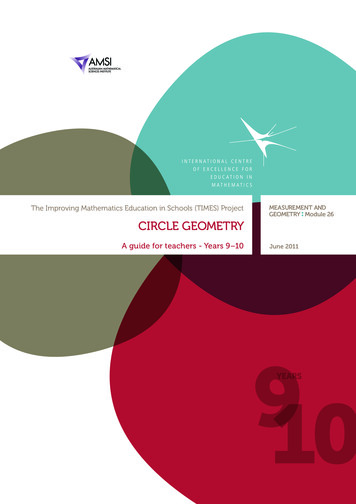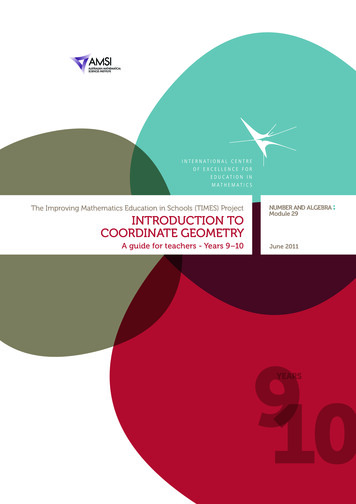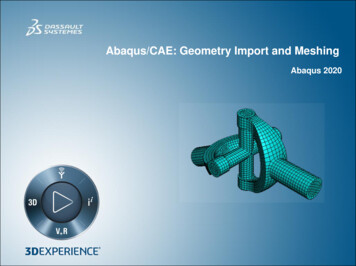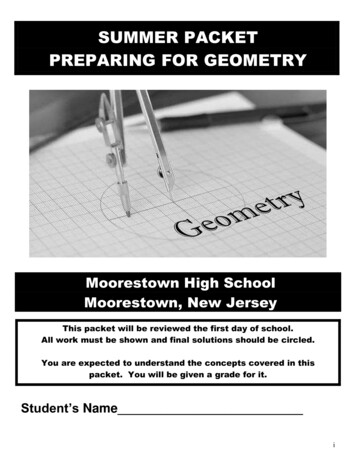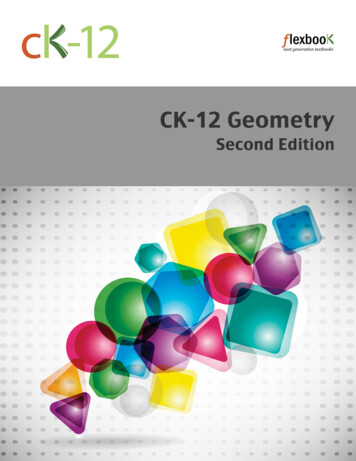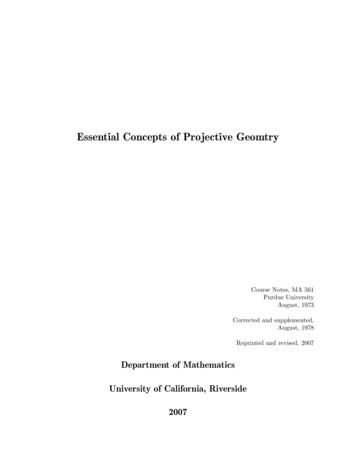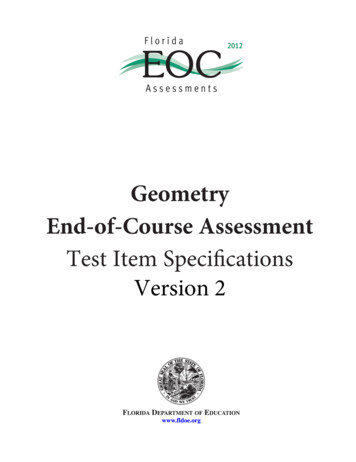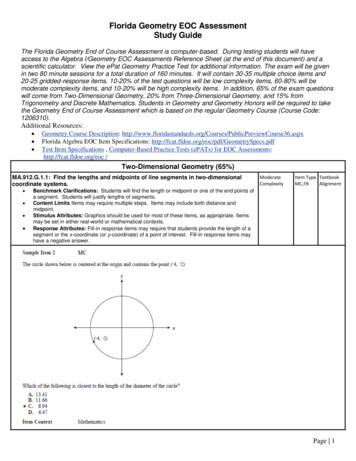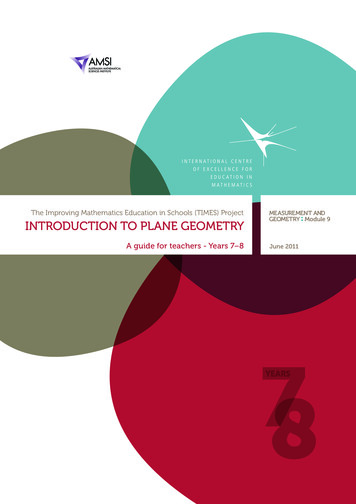
Transcription
The Improving Mathematics Education in Schools (TIMES) ProjectINTRODUCTION TO PLANE GEOMETRYA guide for teachers - Years 7–8 MEASUREMENTANDGEOMETRY Module 9June 201178YEARS
Introduction to Plane Geometry(Measurement and Geometry : Module 9)For teachers of Primary and Secondary Mathematics510Cover design, Layout design and Typesetting by Claire HoThe Improving Mathematics Education in Schools (TIMES)Project 2009‑2011 was funded by the Australian GovernmentDepartment of Education, Employment and WorkplaceRelations.The views expressed here are those of the author and do notnecessarily represent the views of the Australian GovernmentDepartment of Education, Employment and Workplace Relations. The University of Melbourne on behalf of the InternationalCentre of Excellence for Education in Mathematics (ICE‑EM),the education division of the Australian Mathematical SciencesInstitute (AMSI), 2010 (except where otherwise indicated). Thiswork is licensed under the Creative Commons AttributionNonCommercial-NoDerivs 3.0 Unported License. 3.0/
The Improving Mathematics Education in Schools (TIMES) ProjectINTRODUCTION TO PLANE GEOMETRYA guide for teachers - Years 7–8MEASUREMENT ANDGEOMETRY M odule 9June 2011Peter BrownMichael EvansDavid HuntJanine McIntoshBill PenderJacqui Ramagge78YEARS
{1}A guide for teachersINTRODUCTION TOPLANE GEOMETRYASSUMED KNOWLEDGEStudents will have had extensive informal experience with geometry in earlier years, andthis will provide a good intuitive basis for the more systematic approach to geometryappropriate in Years 7–10. The particular topics from Years F–6 relevant to this module are: The use of compasses and rulers and the careful drawing of geometrical figures. Types of angles, including at least right angles, acute angles, obtuse angles andreflex angles. Triangles, including an informal introduction to isosceles and equilateral triangles. Quadrilaterals, including an informal introduction to squares, rectangles,parallelograms, trapezia and rhombuses. Informal experience with translations, reflections, rotations and enlargements,and with symmetry in the context of activities such as folding an isosceles triangle,rectangle or rhombus.MOTIVATIONGeometry is used to model the world around us. A view of the roofsof houses reveals triangles, trapezia and rectangles, while tilingpatterns in pave ments and bathrooms use hexagons, pentagons,triangles and squares.Builders, tilers, architects, graphic designers and web designersroutinely use geometric ideas in their work. Classifying suchgeometric objects and studying their properties are very important. Geometry alsohas many applications in art.Just as arithmetic has numbers as its basic objects of study, so points, lines and circles arethe basic building blocks of plane geometry.
The Improving Mathematics Education in Schools (TIMES) ProjectIn secondary school geometry, we begin with a number of intuitive ideas (points, linesand angles) which are not at all easy to precisely define, followed by some definitions(vertically opposite angles, parallel lines, and so on) and from these we deduce importantfacts, which are often referred to as theorems. In secondary school, the level of rigourshould develop slowly from one year to the next, but at every stage clear setting out isvery important and should be stressed.Thus geometry gives an opportunity for students to develop their geometric intuition,which has applications in many areas of life, and also to learn how to construct logicalarguments and make deductions in a setting which is, for the most part, independentof number.CONTENTPOINTS AND LINESThe simplest objects in plane geometry are points and lines. Because they are so simple,it is hard to give precise definitions of them, so instead we aim to give students a roughdescription of their properties which are in line with our intuition. A point marks a positionbut has no size. In practice, when we draw a point it clearly has a definite width, but itrepresents a point in our imagination. A line has no width and extends infinitely in bothdirections. When we draw a line it has width and it has ends, so it is not really a line, butrepresents a line in our imagination. Given two distinct points A and B then there is one(and only one) line which passes through both points. We use capital letters to refer topoints and name lines either by stating two points on the line, or by using small letterssuch as ℓ and m. Thus, the given line below is referred to as the line AB or as the line ℓ.BPA{2}
{3}A guide for teachersGiven two distinct lines, there are two possibilities: They may either meet at a single pointor they may never meet, no matter how far they are extended (or produced). Lines whichnever meet are called parallel. In the second diagram, we write AB CD.CDABThree (or more) points that lie on a straight line are called collinear.Three (or more) lines that meet at a single point are called concurrent.CBACollinearConcurrentEXERCISE 1Draw three lines that are not concurrent such that no two are parallel.EXERCISE 2Make a large copy of the diagram below. The points X, Y, Z are any points on the line ℓ andA, B ,C are any points on the line m. Join AY and XB call their inter section R. Join BZ andYC and call their intersection P. Join CX and ZA and call their intersection Q. What do younotice about the points P, Q, R? (This result is called Pappus’ theorem, c. 340 AD.)ℓZYXABCm
The Improving Mathematics Education in Schools (TIMES) Project{4}INTERVALS, RAYS AND ANGLESSuppose A and B are two points on a line. The intervalAB is the part of the line between A and B, including thetwo endpoints.BAThe point A in the diagram divides the line into twopieces called rays. The ray AP is that ray whichcontains the point P (and the point A).PAQAnglesIn the diagram, the shaded region between the raysOA and OB is called the angle AOB or the angleBOA. The angle sign is written so we write AOB.BOAThe shaded region outside is called the reflex angleformed by OA and OB. Most of the time, unless wespecify the word reflex, all our angles refer to thearea between the rays and not outside them.BOATHE SIZE OF AN ANGLEImagine that the ray OB is rotated about the pointO until it lies along OA. The amount of turning iscalled the size of the angle AOB. We can similarlydefine the size of the reflex angle.BOWe will often use small Greek letters, , , , . torepresent the size of an angle.A
{5}A guide for teachersThe size of the angle corresponding to one full revolution was divided (by the Babylo nians) into 360 equal parts, which we call degrees. (They probably chose 360 since it wasclose to the number of days in a year.) Hence, the size of a straight-angle is 180 and thesize of a right-angle is 90 . Other angles can be measured (approximately) usinga protractor.AAOStraight angleBOABRight angleOObtuse angleAngles are classified according to their size. We say that an angle with size is acute(a word meaning ‘sharp’) if 0 90 , is obtuse (a word meaning ‘blunt’) if90 180 and is reflex if 180 360 .Since the protractor has two scales, students need to be careful when drawing andmea suring angles. It is a worthwhile exercise to use a protractor to draw some anglessuch as 30 , 78 , 130 , 163 .EXERCISE 3Fold an A4 sheet of paper matching up the (diagonally)opposite corners. Draw a line along the crease that isformed and measure the angles between the creaseand the side.In the exercise above, the two angles together form a straight line and so add to 180 .Two angles that add to 180 are called supplementary angles; thus 45 and 135 aresupplementary angles.Two angles that add to 90 are called complementary; thus 23 and 67 arecomple mentary angles.B
The Improving Mathematics Education in Schools (TIMES) Project{6}ANGLES AT A POINTTwo angles at a point are said to be adjacent if theyshare a common ray. Hence, in the diagram, AOBand BOC are adjacent.Adjacent angles can be added, so in the diagram .COBAWhen two lines intersect, four angles are formed at the point of intersection.In the di agram, the angles marked AOX and BOY are called vertically opposite.Since AOX is the supplement of BOX (straight angle).Y BOY is also the supplement of BOX (straight angle),we can conclude that these vertically opposite angles, AOX and BOY are equal. We thus have our firstimportant geometric statement:BOAXVertically opposite angles are equal.A result in geometry (and in mathematics generally) is often called a theorem. A theo remis an important statement which can be proven by logical deduction. The argument aboveis a proof of the theorem; sometimes proofs are presented formally after the statement ofthe theorem.If two lines intersect so that all four angles are right-angles,then the lines are said to be perpendicular.Angles at a point – Geometric ArgumentsThe following reasons can be used in geometric arguments: Adjacent angles can be added or subtracted. Angles in a revolution add to 360 . Angles in a straight line add to 180 . Vertically opposite angles are equal.
{7}A guide for teachersTransversals and Parallel LinesA transversal is a line that meets two other lines.Corresponding anglesVarious angles are formed by the transversal. In the diagrams below, the two markedangles are called corresponding angles.We now look at what happens when the two lines cut bythe transversal are parallel.QDInituitively, if the angle were greater than then CDwould cross AB to the left of F and if it were less than ,it would cross to the right of F. So since the lines do notcross at all, can be neither less nor more than and soequals .Alternatively, imagine translating the angle QGD alongGF until G coincides with F. Since the lines are parallel,we would expect that the angle would coincide withthe angle . This observation leads us to conjecture that:GCFAPCorresponding angles formed from parallel lines are equal.B
The Improving Mathematics Education in Schools (TIMES) ProjectWe cannot prove this result, although we have shown that it is geometrically plausible. Wewill accept it as an axiom of geometry. An axiom is a statement which we cannot prove,but which is in tuitively reasonable. Note that many of the facts we have already statedsuch as: adjacent angles may be added, and two points determine a line etc., are alsoaxioms, although we have not explicitly stated them in this way.Alternate AnglesIn each diagram the two marked angles are called alternate angles (since they are onalternate sides of the transversal).If the lines AB and CD are parallel, then the alternateangles are equal. This result can now be proven.QD DGQ (corresponding angles, AB CD)G DGQ (vertically opposite angles at G)CSo .BFAPTo summarise:Alternate Angles formed from parallel lines are equal.Co-interior AnglesFinally, in each diagram below, the two marked angles are called co-interior angles andlie on the same side of the transversal.If the lines AB and CD are parallel, then it is obvious that the co-interior angles are notequal but it turns out that they are supplementary, that is, their sum is 180 .{8}
{9}A guide for teachersQThis is a result which is also easy to prove: BFG (alternate angles, AB CD)DG 180 (straight angle at F)CBFAPTo summarise:Co-interior angles formed from parallel lines are supplementary.The three results can be summarisedby the following diagram: 180 Numerical ExamplesGiven information about the angles in a diagram, we can use the above results to find thesize of other angles in the diagram. This is a simple but very impor tant skill, often referredto informally as angle chasing. In solving problems, the sequence of steps is not alwaysunique. There may be several different, but equally valid, approaches.For example, in the following diagram, we seek the size of angle BAC.ABCD 102 DCA 102 (alternate angles, AC BD) BAC 78 (co-interior angles, AB CD)EXERCISE 4Use an alternatie sequence of steps to find BAC.
The Improving Mathematics Education in Schools (TIMES) ProjectEXERCISE 5CUsing only properties of parallel lines,find (with reasons) the missing anglesin the following diagram.M80 65 ABEXERCISE 6Find the value of in the following diagram.C2MABCONVERSE STATEMENTSMany statements in mathematics have a converse, in which the implication goes in theopposite direction. For example, the statement‘Every even number ends in 0, 2, 4, 6 or 8.’has converse‘Every number that ends in 0, 2, 4, 6 or 8 is even.’This particular statement and its converse are both true, but this is by no means alwaysthe case.For example, the following two statements are converses of each other:‘Every multiple of 4 is an even number.’‘Every even number is a multiple of 4.’and here, the first statement is true, but the second is false.E{10}
{11}A guide for teachersEXERCISE 7Write down:a a true geometrical statement whose converse is also true,b false geometrical statement whose converse is true,c a false geometrical statement whose converse is also false.The Converse Theorems for Parallel LinesWe have seen that corresponding angles formed from parallel lines are equal. We canwrite down the converse statement as follows.Statement: If the lines are parallel, then the corresponding angles are equal.Converse: If the corresponding angles are equal, then the lines are parallel.The converse statement is also true and is often used to prove that two lines are paral lel.The same is true in regard to alternate and co-interior angles.Statement: If the lines are parallel, then the alternate angles are equal.Converse: If the alternate angles are equal,then the lines are parallel.Statement: If the lines are parallel, then the co-interior angles are supplementary.Converse: If the co-interior angles are supplementary, then the lines are parallel.Thus, in each diagram, the lines AB and CD are parallel.ABAAB180 –CBDDCDCEXERCISE 8AWhich value of will make AB parallel to CD?B100 ( 30) DC
The Improving Mathematics Education in Schools (TIMES) ProjectAProofs of the Three ConversesWe suppose that the corresponding anglesformed by the transversal are equal and weshow that the lines are parallel.BCDIn the diagram, we suppose that ABC BEF.EFIf BC and EF are not parallel, then drawBD parallel to EF.GNow since BD and EF are parallel ABD BEF and so ABC ABD which is clearlyimpossible unless the lines BC and BD are the same. Hence the lines BC and EF are parallel.The other proofs follow in the same fashion.EXERCISE 9Give a proof of the second converse theorem (alternate angles).ANGLE SUM OF A TRIANGLEThe results from the previous section can be usedto deduce one of the most important facts ingeometry – the angle sum of a triangle is 180 .ADEWe begin with triangle ABC with angles , , asshown. Draw the line DAE parallel to BC. Then, DAB (alternate angles, BC DE)B EAC (alternate angles, BC DE) 180 (straight angle).Thus, we have proven the theoremThe sum of the angles in a triangle is 180 .A quadrilateral is a plane figure bounded by four sides.C{12}
{13}A guide for teachersEXERCISE 10By dividing the quadrilateral ABCD into two triangles, find the sum of the angles.DBCCDABALINKS FORWARDThe material in this module has begun to place geometry on a reasonably systematicfoundation of carefully defined objects, axioms that are to be assumed, and theoremsthat we have proven. On this basis, we can develop a systematic account of planegeometry involving: Pythagoras’ theorem congruence and congruent triangles similarity and similar triangles isosceles and equilateral triangles special quadrilaterals, including squares, rectangles, parallelograms,rhombuses and trapezia the geometry of circles.Plane geometry will also be fundamental in many other areas of Years 7–10 mathematics: transformations three-dimensional geometry areas and volumes trigonometry coordinate geometry the graphs of circles and parabolas.The ideas of tangents and areas lead in turn to calculus in Years 11–12.
The Improving Mathematics Education in Schools (TIMES) ProjectHISTORY AND APPLICATIONHistoryThe incredible constructions of the pyramids and the huge temples of Egypt reveal thatthe Egyptians must have had a very good working knowledge and understanding of basicgeometry, at least at a practical level. On the other hand, there is no evidence that theyhad systematised that knowledge in any formal way. This was left to the ancient Greeks.We do not have detailed knowledge of that systematisation, except for the claim thatThales (ca. 624 BC-ca. 546 BC) gave the first ‘proofs’ of geometric facts which markedthe beginnings of deductive geometry. The Pythagorean School continued this workand Plato (428 BC -348 BC) is clearly drawing on the work of earlier mathematicianswhen he mentions geometric facts in his writings. The geometric dialogue in his workthe Meno, in which Socrates gets a slave boy to arrive at a geometric theorem by a seriesof logical deductions, is worth a read. If the origins of geometry are unclear, the ‘finalproduct’ is not. Euclid (323-283 BC), writing in Alexandria, produced a remarkable work,called the Elements, which remained the standard textbook in geometry for more than2000 years. In this work, Euclid sets out a number of definitions (such as for points andlines), postulates, and common notions. (These days we call them axioms.) From these,he logically developed, in a very carefully chosen order, a great many theorems which wegenerally refer to as Eu clidean Geometry. There are a number of other geometric results,such as Pappus’ theorem, that were discovered after Euclid, but these are not generallycovered in secondary school.One of Euclid’s five postulates was not as obviously true as the others seemed to be.One version of it, known as Playfair’s Axiom states that: Given a line ℓ and a point P, noton ℓ, there is one and only one line parallel to ℓ passing through P. In the 19th century, anumber of mathematicians asked the question ‘What happens if we deny this postulate?’This is done by assuming that either there is no such parallel line, or by saying that there ismore than one such line. This led to the development of non-euclidean geometries, oneof which has turned out to provide one of the good models for the universe.ApplicationsIn a very real sense, geometry and geometric intuition form the underpinnings of allMath ematics – geometry leads to coordinate geometry which leads to calculus andall its many applications – and so is crucial in the curriculum.On a more practical level, builders, surveyors, engineers and architects have beenheavy users of geometry and geometric ideas for centuries. More recently, with thedevelopment of computers, graphic artists and web designers have joined this groupof people who need and use geometry in their work. When asked recently how usefulgeometry is, Jim Kelly, an applied scientist said: . geometry is an important part ofdesign, drawing, and computer modeling. It also is used frequently in . physics and otherphysical science courses as part of understanding the effects of loads on structures andbalancing points(centers of gravity) for composite solids. In chemistry, understanding thegeometry of a molecule is related to understanding the properties of substances. Manymore examples exist. (from Ask a Scientist website.){14}
{15}A guide for teachersREFERENCESA History of Mathematics: An Introduction, 3rd Edition, Victor J. Katz, Addison-Wesley,(2008)History of Mathematics, D. E. Smith, Dover Publications, New York, (1958)ANSWERS TO EXERCISESEXERCISE 1EXERCISE 2The points are collinearEXERCISE 360EXERCISE 4DBA 102 (corresponding angles, AB CD)BAC 78 (co-interior angles, AC BD)EXERCISE 5 65(corresponding angles, AC BM) 80(alternate angles, AC BM) (co-interior angles, AC BM) 115Therefore, 35(This is the structure for a proof of the result that the angle sum of a triangle is 180 )
The Improving Mathematics Education in Schools (TIMES) ProjectEXERCISE 6 60 EXERCISE 7a A quadrilateral with each of its interior angles a right angle is a rectangle.Converse: Each interior angle of a rectangle is a right angle.b A rectangle is a squareConverse: A square is a rectanglec The angle sum of the interior angles of a triangle is 200 Converse: A polygon for which the sum of the interior angle is 200 is a triangle.EXERCISE 8 50 EXERCISE 9We refer to the same diagram.Place a point H on the line EF to the left of E. CBE BEHIf BC and EF are not parallel then draw BD parallel to EF.Since BD and EF are parallel, EBD BEH, which is clearly impossible unless the linesBC and BD are the same.Hence the lines BC and EF are parallel.EXERCISE 10360 {16}
The aim of the International Centre of Excellence forEducation in Mathematics (ICE-EM) is to strengtheneducation in the mathematical sciences at all levelsfrom school to advanced research and contemporaryapplications in industry and commerce.ICE-EM is the education division of the AustralianMathematical Sciences Institute, a consortium of27 university mathematics departments, CSIROMathematical and Information Sciences, the AustralianBureau of Statistics, the Australian Mathematical Societyand the Australian Mathematics Trust.The ICE-EM modules are part of The ImprovingMathematics Education in Schools (TIMES) Project.The modules are organised under the strandtitles of the Australian Curriculum: Number and Algebra Measurement and Geometry Statistics and ProbabilityThe modules are written for teachers. Each modulecontains a discussion of a component of themathematics curriculum up to the end of Year 10.www.amsi.org.au
Introduction to Plane Geometry (Measurement and Geometry : Module 9) For teachers of Primary and Secondary Mathematics 510 Cover design, Layout design and Typesetting by Claire Ho The Improving Mathematics Education in Schools (TIMES) Project 2009‑2011 was funded by the Australian Government Department of Education, Employment and Workplace
